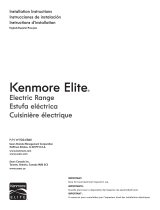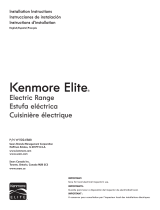
5
Electrical Requirements
If codes permit and a separate ground wire is used, it is
recommended that a qualified electrical installer determine that
the ground path and wire gauge are in accordance with local
codes.
Do not use an extension cord.
Be sure that the electrical connection and wire size are adequate
and in conformance with all local codes and ordinances.
WARNING: Improper connection of the equipment-grounding
conductor can result in a risk of electric shock. Check with a
qualified electrician or service technician if you are in doubt as to
whether the appliance is properly grounded. Do not modify the
power supply cord plug. If it will not fit the outlet, have a proper
outlet installed by a qualified electrician.
Electrical Connection
To properly install your range, you must determine the type of
electrical connection you will be using and follow the instructions
provided for it here.
■ Range must be connected to the proper electrical voltage
and frequency as specified on the model/serial rating plate.
The model/serial rating plate is located on the frame behind a
top corner of the door or either side of the drawer. Refer to
the figures in “Product Dimensions” in the “Location
Requirements” section.
*If connecting to a 50-amp circuit, use a 50-amp rated cord with
kit. For 50-amp rated cord kits, use kits that specify use with a
nominal 1³⁄₈" (34.9 mm) diameter connection opening.
■ A circuit breaker is recommended.
■ The range can be connected directly to the circuit breaker
box (or fused disconnect) through flexible or nonmetallic
sheathed, copper or aluminum cable. See the “Electrical
Connection” section.
■ Allow 2 to 3 ft (61.0 cm to 91.4 cm) of slack in the line so that
the range can be moved if servicing is ever necessary.
■ A UL listed conduit connector must be provided at each end
of the power supply cable (at the range and at the junction
box).
■ Wire sizes and connections must conform with the rating of
the range.
■ The wiring diagram is located on the Tech Sheet.
■ The Tech Sheet is located on the back of the range inside a
clear plastic bag.
If connecting to a 3-wire system:
Local codes may permit the use of a UL listed, 3-wire, 250-volt,
40- or 50-amp range power supply cord (pigtail). This cord
contains 3 copper conductors with ring terminals or open-end
spade terminals with upturned ends, terminating in a IEC 60309
plug on the supply end. Connectors on the appliance end must
be provided at the point the power supply cord enters the
appliance. This uses a 3-wire receptacle of IEC 60309.
Range Rating Specified Rating of
Power Supply Cord Kit
and Circuit Protection
220 Volts 230 Volts Amps
7.4 - 13.8 KW
13.9 - 18.9 KW
8.1 - 15.1 KW
15.1 - 20.6 KW
40 or 50*
50
3-wire receptacle (IEC 60309)













